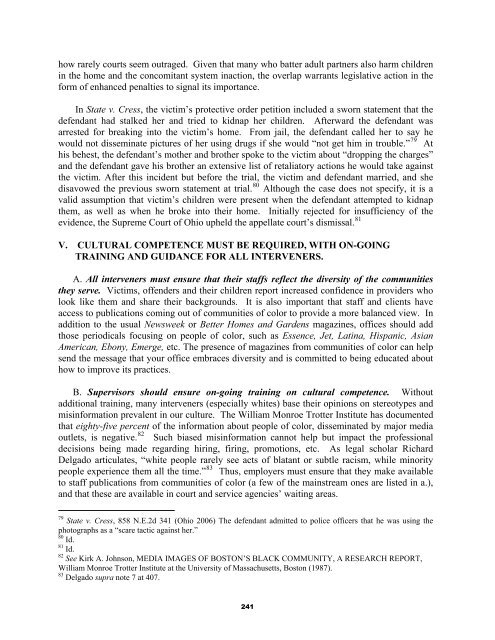A Judge’s Guide
A Judge’s Guide
A Judge’s Guide
You also want an ePaper? Increase the reach of your titles
YUMPU automatically turns print PDFs into web optimized ePapers that Google loves.
how rarely courts seem outraged. Given that many who batter adult partners also harm children<br />
in the home and the concomitant system inaction, the overlap warrants legislative action in the<br />
form of enhanced penalties to signal its importance.<br />
In State v. Cress, the victim’s protective order petition included a sworn statement that the<br />
defendant had stalked her and tried to kidnap her children. Afterward the defendant was<br />
arrested for breaking into the victim’s home. From jail, the defendant called her to say he<br />
would not disseminate pictures of her using drugs if she would “not get him in trouble.” 79 At<br />
his behest, the defendant’s mother and brother spoke to the victim about “dropping the charges”<br />
and the defendant gave his brother an extensive list of retaliatory actions he would take against<br />
the victim. After this incident but before the trial, the victim and defendant married, and she<br />
disavowed the previous sworn statement at trial. 80 Although the case does not specify, it is a<br />
valid assumption that victim’s children were present when the defendant attempted to kidnap<br />
them, as well as when he broke into their home. Initially rejected for insufficiency of the<br />
evidence, the Supreme Court of Ohio upheld the appellate court’s dismissal. 81<br />
V. CULTURAL COMPETENCE MUST BE REQUIRED, WITH ON-GOING<br />
TRAINING AND GUIDANCE FOR ALL INTERVENERS.<br />
A. All interveners must ensure that their staffs reflect the diversity of the communities<br />
they serve. Victims, offenders and their children report increased confidence in providers who<br />
look like them and share their backgrounds. It is also important that staff and clients have<br />
access to publications coming out of communities of color to provide a more balanced view. In<br />
addition to the usual Newsweek or Better Homes and Gardens magazines, offices should add<br />
those periodicals focusing on people of color, such as Essence, Jet, Latina, Hispanic, Asian<br />
American, Ebony, Emerge, etc. The presence of magazines from communities of color can help<br />
send the message that your office embraces diversity and is committed to being educated about<br />
how to improve its practices.<br />
B. Supervisors should ensure on-going training on cultural competence. Without<br />
additional training, many interveners (especially whites) base their opinions on stereotypes and<br />
misinformation prevalent in our culture. The William Monroe Trotter Institute has documented<br />
that eighty-five percent of the information about people of color, disseminated by major media<br />
outlets, is negative. 82 Such biased misinformation cannot help but impact the professional<br />
decisions being made regarding hiring, firing, promotions, etc. As legal scholar Richard<br />
Delgado articulates, “white people rarely see acts of blatant or subtle racism, while minority<br />
people experience them all the time.” 83 Thus, employers must ensure that they make available<br />
to staff publications from communities of color (a few of the mainstream ones are listed in a.),<br />
and that these are available in court and service agencies’ waiting areas.<br />
79<br />
State v. Cress, 858 N.E.2d 341 (Ohio 2006) The defendant admitted to police officers that he was using the<br />
photographs as a “scare tactic against her.”<br />
80<br />
Id.<br />
81<br />
Id.<br />
82<br />
See Kirk A. Johnson, MEDIA IMAGES OF BOSTON’S BLACK COMMUNITY, A RESEARCH REPORT,<br />
William Monroe Trotter Institute at the University of Massachusetts, Boston (1987).<br />
83<br />
Delgado supra note 7 at 407.<br />
241


